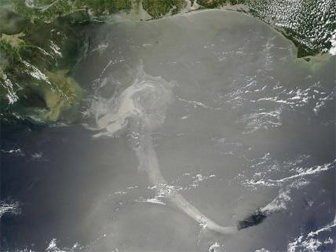Researchers at the Woods Hole Oceanographic Institution (WHOI) have detected a plume of hydrocarbons that is at least 22 miles long and more than 3,000 feet below the surface of the Gulf of Mexico, a result of the BP Deepwater Horizon oil spill, reports a study published in Science.
The 1.2-mile-wide, 650-foot-high plume of trapped hydrocarbons provides a clue on where all the oil has gone as oil slicks on the surface disappear.
“These results indicate that efforts to book keep where the oil went must now include this plume,” said Christopher Reddy, a WHOI marine geochemist and oil spill expert and one of the authors of the study, in a statement.
 NASA’s Terra satellite captured a visible satellite image of the Gulf oil spill on May 17 at 16:40 UTC (12:40 p.m. EDT) from the Moderate Resolution Imaging Spectroradiometer Instrument on-board. The oil slick appears as a dull gray on the water’s surface and stretches south from the Mississippi Delta with what looks like a tail. Text Credit: NASA Goddard / Rob Gutro |
The findings are based on 57,000 discrete chemical analyses measured in real time using an autonomous underwater vehicle and a type of underwater mass spectrometer known as TETHYS (Tethered Yearlong Spectrometer) during a June 19-28 scientific cruise aboard the R/V Endeavor. The R/V Endeavor is owned by the National Science Foundation (NSF) and operated by the University of Rhode Island.
““We’ve shown conclusively not only that a plume exists, but also defined its origin and near-field structure,” said WHOI’s Richard Camilli, leader of the research expedition and lead author of the paper. “Until now, these have been treated as a theoretical matter in the literature.”
The scientists found that the plume is degrading “relatively slowly” meaning that it “will persist for some time,” according to the press statement.
“Many people speculated that subsurface oil droplets were being easily biodegraded,” said Camilli. “Well, we didn’t find that. We found it was still there.”
The spill, which started after a well blowout on April 20, 2010, is estimated by the government at 4.9 million barrels, the largest in U.S. history.
Related articles







